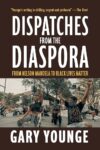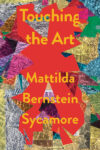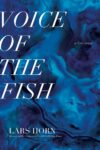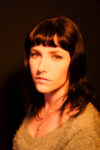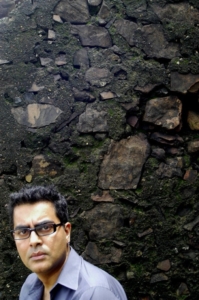 It was a Sunday afternoon and I was tired of the Brooklyn Book Festival. I had browsed the pop-up tents outside Borough Hall. I had dutifully attended some panels. I should have gone to the People’s Climate March, I thought to myself.
It was a Sunday afternoon and I was tired of the Brooklyn Book Festival. I had browsed the pop-up tents outside Borough Hall. I had dutifully attended some panels. I should have gone to the People’s Climate March, I thought to myself.
Shortly after this moment of doubt, I found myself listening to Amitava Kumar. He talked about researching and writing A Matter of Rats, a “short biography” of his hometown of Patna, India. He talked about rats that outsmart doctors and rats that steal dentures. Kumar did more than talk: he slapped a fellow panel member on the back, gave shout-outs to students, and worked the audience, ranging into the seats to fetch a copy of Rats. He had forgotten the book, and had sent out a distress signal on Twitter. Even coming, as it did, at the end of a very long day, Kumar’s energy was infectious.
Kumar is a writer, journalist, scholar, teacher, and showman. He holds the Helen D. Lockwood Chair in English at Vassar College, and his books are wide-ranging: nonfiction works like A Foreigner Carrying in the Crook of His Arm a Tiny Bomb and A Matter of Rats sit comfortably alongside a novel (Nobody Does The Right Thing), a critical report on Indian fiction (Bombay-London-New York), and a book containing theory, poetry, cultural criticism, and photography (Passport Photos). What stays constant is Kumar’s distinct voice: smart but self-deprecating, journalistic but intimate, rigorous but relaxed.
Kumar and I corresponded over email about A Matter of Rats, drones, academia, and the importance of style. After the interview was over, I received an email from Kumar. He told me he had wanted to quote from a letter that Virginia Woolf wrote to Vita Sackville-West, but was unable to find the quote when answering my questions. The line he wanted reads: “Style is a very simple matter; it is all rhythm. Once you get that, you can’t use the wrong words.”
Ben Sandman: I think of you as a writer of nonfiction. Over the years, though, your writing has taken a number of forms: essays, poetry, fiction, and documentary film. In A Matter of Rats, you weave genres together — criticism, reportage, travel writing, memoir. Do you know what form each project will take when you start it? Have you ever gotten it wrong?
Amitava Kumar: A Matter of Rats was non-fiction; most of my books have been just that. With Rats, I had the voice right away. It is such a gift when that happens. I wrote a novel a few years ago, but it had started as a nonfiction project. I was doing a lot of interviews with a Bollywood actor and then thought I could give it a greater density or texture by turning it into fiction. Was I wrong to do that? I remain unsure to this day. Maybe one ought to write something as fiction from the very start. It is significant that the novel was titled Nobody Does the Right Thing.
How would you describe your voice in Rats?
It is a mix between a reporter’s voice and the voice of a memoirist. This voice is similar to what I’ve used in other books except what is more marked in Rats is the intimacy and the betrayal. I was writing about what once was home, hence the intimacy. I wanted to be honest and not hold anything back. Therefore the hint, I won’t call it guilt, of betrayal.
The book is very personal — did that make it easier to write, or more difficult?
The decision to be honest, and to be open about one’s betrayals, actually made it easier to write. It opened a space for expression. I don’t know what kind of a writer Richard Peck is but the other day I saw a quote attributed to him: “The only way you can write is by the light of the bridges burning behind you.” I could immediately relate to that.
At the Brooklyn Book Festival you touched on the relationship between author and subject. My notes read: “Writing = Betrayal.” You wrote about a failed marriage between friends in Rats. Did they see this as a betrayal? Have you ever revealed something in your writing that you later regretted?
Yes. I was following Colm Tóibín’s dictum: “You have to be a terrible monster to write.” Everything is material, even confidences that someone has indiscreetly shared with you. In Rats, I was talking of a Patna poet who had told me of the infidelities in his marriage by telling me a story about Bertrand Russell and how he had offered his wife’s lover a room in his house. According to my friend, Russell didn’t want his wife to do things in public what could be discreetly done in private. There was more that he revealed and then his estranged wife shared her own secrets too. I didn’t now who was right; most likely they were both wrong. I thought it made a great story. It also said something about my town and about how people thought about the role of women.
The poet saw it as a betrayal but I saw him a few months later at my mother’s funeral. I appreciated his gesture. I didn’t ask him about it but I wondered whether, as a writer, he understood what I had done. And whether he had told himself that he would have done the same. I had no doubt I would write about him and his marriage but I wasn’t writing entirely without regret. It’s just that telling the story was more important than my feelings about it.
There’s a mini-manifesto on nonfiction in the acknowledgements section of Rats. Many people, you say, attribute the recent increase in nonfiction writing to the “public’s hunger for truth.” It’s a line of thinking with which you disagree. You write: “There is no truth in nonfiction; there is only perspective.” If you don’t buy this narrative about truth, how do you explain the rise of nonfiction in recent years?
Yes, David Shields calls it “reality hunger.” I don’t know why nonfiction is more popular these days. Perhaps because all the work that the novel used to do is now being done by popular media. Earlier, the report on social space as well as a look at the interior life was to be found in novels. Now you just put on the TV. One person is spilling their guts out on one channel. On another channel, a talking head is explaining everything in soundbites. What are you going to do? Anna Karenina has just come out of rehab. She shows up on Oprah. As a writer, you try to score the book deal which will tell Anna’s story in 300 pages.
In that note in Rats, the one that you are referring to, I wanted to make the point that nonfiction is also fiction. The world is accessed through language. What is real is visible to us only when seen through the literary lens. Style, whether in fiction or nonfiction, is always, always, always, the curry in which the goat gets cooked.
Were you reading non-fiction at a young age? Who were some early influences?
Not real nonfiction, but journalism, yes. I was reading newspapers. I wanted to write for them. There was a journalist from my hometown in India who wrote pieces in the national press — he was a model. But the real influence was George Orwell. It also helped that he had been born in a hospital half an hour away from my village. His father had been an opium agent for the British.
What appealed to you about Orwell?
When I read “Shooting an Elephant,” it seemed he was writing about a milieu I was familiar with. That gave me an in. But the real influence was reading his essay “Why I Write.” I must have been sixteen or seventeen. In that essay, Orwell had much of interest to say about writing but at that time most of those things meant little to me. What had enormous meaning was a simple paragraph describing an activity of his since childhood: there was a silent voice in his head which put into words what he was doing or what he saw. I think he called it “a diary existing only in the mind.” When I read it, I got a key to language. I would struggle to put into words, maybe only as a mental exercise, what I was seeing in the street around me. But it took me a long time to get to the point where that voice could be used to do the kind of journalism that Orwell practiced. A man walking to the gallows — he is about to be hung — steps aside to avoid the puddle . . . I tell my students that we must all emulate in our writing, certainly in our journalism, that way of seeing.
I see the influence of newspaper journalism in your work. How important are interviews? Do you have a particular method? I keep thinking about a moment in A Foreigner Carrying in the Crook of His Arm a Tiny Bomb. You’re speaking with Hemant Lakhani, a man convicted of arms dealing, and, in an attempt to win you over, he mentions his “platinum credit card from British Airways.” Lakhani says: “They used to keep their plane waiting for me.” It’s funny but also deeply sad. A line like that must justify the hard work.
Thank you. But, you know, I’m aware only of my failings as an interviewer. I sometimes think I’m not good because I catch myself trying to charm my subject; at other times, I’m aware that politeness or courtesy makes me reluctant to ask an awkward question. I live in awe of those writers and journalists who spend months, even years, with their interviewees. I’m thinking of someone like Adrian Nicole LeBlanc. But there are many others whose stories reveal such depths. I began working on a story three years ago where my subject would lie to me. I don’t think I ever pointed this out to him. I thought it would hurt my story. Then he asked me to loan him some money. It was a lot he was asking for. I gave it to him, despite the advice of my friends. I haven’t got the money back. But the story I had begun writing isn’t finished either. This is the longest I’ve interacted with an interviewee, and who knows, maybe the reason for this is just that I need him to return my money.
Maybe he’ll see this and send you a check. What’s the story about?
It began as a story about terror. But I think it is now more about a brown man’s marriage to a white woman.
In Foreigner, you considered the political and artistic responses to terror. It’s been four years since that book was published, and America’s political situation, with regards to terrorism, feels largely unchanged; Guantanamo remains open and the CIA continues to practice extraordinary rendition. You wrote about our “bogus familiarity” with terrorists, which comes from seeing them on a screen — has art helped us move toward a more truthful perspective?
I wrote several letters of recommendation for two friends: one is an artist who wanted to make large-scale installations of drones and the other is a writer interested in presenting accounts of drone pilots. As far as I know, both of them received zero funding. Now, does art help us move toward a more truthful perspective? Sure, but it is a fight. A somewhat contested claim I make in the book is that art was ahead of literature in responding to the global war on terror. You are giving me a chance to say that television is ahead of art and literature.
In July, you gave the keynote at a conference on the work of Geoff Dyer. As one writer pointed out in the LA Review of Books, to hold a conference on Dyer seems bizarre. This is a man who has written that academic prose “kills everything it touches.” You’re similarly critical; in Rats, you decry the “deadening language of academia.” How does scholarly work affect your writing? Do you ever find yourself using “deadening language?”
Dead language. It is a constant affliction. Particularly when I’m writing grant proposals. Abstract nouns like dead flies. That might be one of the reasons I prefer reporting. Concrete details — the broken glass on the window, the yellow and green doll on the floor, a photograph on the wall — give writers a chance to avoid biting air.
I’ve mocked academic language when it is jargony, yes, but unlike those who jump on the anti-intellectual bandwagon, my attempt is to also strive for complexity. It’s a delicate dance and I can’t claim I don’t stumble often.
You’ve mentioned an ongoing project about academic style. How’s that coming?
I started work on it around the time Obama took office. I remember telling friends about it on the day of Obama’s inauguration. And now we are closing in on the day when Obama will leave office. I hope to God I finish it! I don’t want this project to go the way of his healthcare plan.
I started the project to rail against the formulaic language we adopt as academics. But I also had other aims. I wanted to present readers with examples of academic writers who have a fine presence on the page. I’m a bit divided on the structure I have adopted so far — the book starts with a shove that turns into an embrace.
Which academic writers get it right, do you think?
There’s a whole range. A few of the folks I interview in the book and ask to share their mantras for writing are: Andrew Ross on scholarly reporting, Cathy Davidson on public writing, Anna Tsing and Katie Stewart on anthropology, Saidiya Hartman and Colin Dayan on race and law, Josh Kun on music, Sukhdev Sandhu on the street at night, Rob Nixon on the environment, and though I haven’t talked to her yet, Susan Stewart for her work on aesthetics.
Would these mantras be helpful for people writing outside of academia?
I think what the writers have to say about the best advice they got about writing, or who their models were in grad school, is mostly going to benefit younger scholars and grad students. That sort of thing isn’t taught in our classes. But the lay reader, someone outside the academy, what a reader like that doesn’t learn and could benefit from is the lesson that is dinned into the heads of students in higher education, at least in the humanities — question the common sense, read against the grain, cultivate a nose for ideology critique. I find that trait invaluable. It is the best thing I learned in college. Not so much research, but the habit of reflection.
You aren’t shy about including students in your writing. Considering that almost all writers teach, it doesn’t seem like many bother to write about it. When pressed, most say: “I learn from my students.” Can you say something more interesting? How does teaching influence what you write?
This subject has weighed on my mind for a long time. I haven’t gone beyond a sketch or two but my ambition is to mix together things that I know about the academy and immigration, and, if this doesn’t sound too pompous, the politics of knowledge. A book waiting for me on my bookshelf is Stoner. I have several other titles waiting too, including The Group, which any self-respecting academic associated with Vassar should have read by now. I want to teach a course with a title like “The Campus Novel.” Maybe that will allow my plans to graduate into something more interesting.
You’ve taught a class on the literature of 9/11 — what’s on that reading list?
That list changes. When I first taught it here at Vassar it had non-fiction like the 9/11 Commission Report and Lawrence Wright’s Looming Tower mixed with novels like DeLillo’s Falling Man and a short-story by Deborah Eisenberg called “Twilight of the Superheroes.” In its latest incarnation, a bit more prominent in the list were testimonies from Guantanamo and reports from Iraq and Afghanistan (David Finkel, Dexter Filkins) mixed with novels like Claire Messud’s The Emperor’s Children and Mohsin Hamid’s The Reluctant Fundamentalist. In a way, the course has now become more about the distant places where the shadow of the no towers has fallen. You understand?
Yes, that makes sense — as the repercussions of the event spread out through the world, the “literature of 9/11” widens in scope. You have a new essay collection being published in May. It’s called Lunch with a Bigot. Who’s the bigot? What’s in the collection?
The bigot is a man who put me on a “hit-list” after I wrote an article about my marriage. I am Indian, and a Hindu. My wife is a Pakistani Muslim. When we got married, our countries were at war with each other. I published an essay in an Indian newspaper. It was titled “Marriage for Peace.” The title was inspired by a sign I had seen earlier that week at a cricket match. India and Pakistan were playing in the semi-final at the cricket World Cup. A spectator was wearing a placard that said “Cricket for Peace.”
Anyway, that essay you are talking about, in the collection that is coming out, is an account of my meeting with the right-wing Hindu nationalist. The collection has twenty-odd essays divided in four sections: Reading, Writing, Places, People. The title-essay appears in that last section. I want to mention here that the man I went to meet wasn’t so much of a stranger as I had at first imagined. I recognized myself, or at least my past, in him. In other words, I too am a bit of a bigot.
Before I let you go — any advice for young writers?
Writers are daunted by this demand. I remember what Barbara Kingsolver once told her audience at Duke University, “It is harrowing for me to try to teach 20-year-old students, who earnestly want to improve their writing. The best I can think to tell them is: Quit smoking, and observe posted speed limits. This will improve your odds of getting old enough to be wise.” I offer a brief mantra to my writing students. “Write every day and walk every day.” It needn’t be a lot. If you make a habit of writing 150 words every day, and if you walk mindfully for even 15 minutes each day, you will build a habit that will put you on the road to becoming a Jedi Knight.
Ben Sandman, of Delhi, NY, graduated from Vassar College. His short fiction has appeared or is forthcoming in Stirring, Susquehanna Review, and The Allegheny Review, which awarded his story “Midway” its 2014 prize for prose. He lives in Brooklyn.
This post may contain affiliate links.




